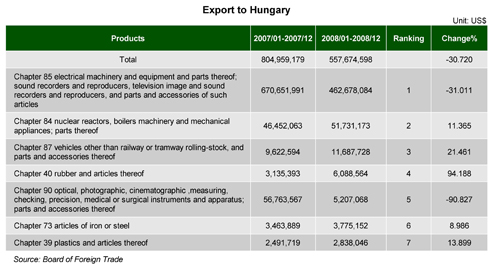Taiwan Acts to Help Local Suppliers Boost Exports to Emerging Markets
2009/06/09 | By Philip LiuTo cope with the battering from the global recession upon Taiwan's exports, the Taiwan government has been doing all it can to help local exporters tap emerging markets, whose demand remain relatively strong, to compensate for steep declines in exports to major markets in the U.S., Western Europe, and China.
Taiwan's exports began to slip steadily since September 2008, when it dropped 1.6% year-on-year. The decline grew to 8.3% in October before plunging 23.3% in November and 41.9% in December. Last year saw Taiwan exports inch up 3.6% to US$255.7 billion and imports rise 9.8% to US$240.8 billion, for a trade surplus of US$14.8 billion. Without a sign of a turnaround, exports continued to plummet 36.6% in the first quarter of 2009 to US$40.55 billion, with the Ministry of Finance predicting that exports will not recover until the fourth quarter this year, at the earliest.
Demands from the U.S. and Western Europe shrank drastically starting from the fourth quarter of 2008, during which Taiwan's exports to the U.S. tumbled 4% to US$30.8 billion, and only rose 5.1% to US$25 billion in shipments to the 15 original members of the European Union.
Global Supply-chain Broken
With sapping demand from the U.S. and Western Europe breaking the global supply chain, Taiwan's shipments to China also crashed as China is the island's largest buyer. After all, a major portion of Taiwan's exports to China consist of machinery, 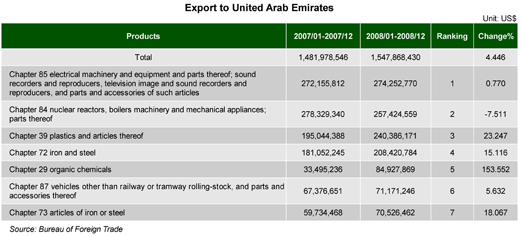
components and raw materials used to turn out products exported to the U.S. and Western Europe.
Taiwan's shipments to China/Hong Kong plummeted 38.8% year-on-year to US$4.16 billion last November, far below the monthly figure US$6-7 billion in the previous months, plunging another 54% in December. In 2008, Taiwan's shipments to China/Hong Kong dipped 0.82% to US$99.6 billion, 39% of its overall exports.
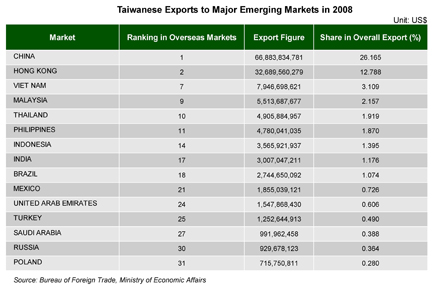
Such gloomy export performance has rocked Taiwan's economy, as 60% of its gross domestic product is generated by exports. Hitting the panic button to help local exporters look for greener pastures amid the rough global business climate, the Taiwan Cabinet passed the "New Zheng He Plan" last December, designed to tap emerging and Chinese markets. Zheng He was a famous Chinese explorer who captained huge armadas to sail to the South Pacific, Indian Ocean, Taiwan, Persian Gulf, and distant Africa from 1405 to 1433.
BRIC-market Focused
Budgeted at NT$8.5 billion (US$250 million, at US$1=NT$34) and to be executed during 2009-2012, the plan focuses on the markets of the BRICs (Brazil, Russia, India, and China), ASEAN (Association of Southeast Asian Nations), and the Middle East, aiming to help boost exports by 6-7% a year.
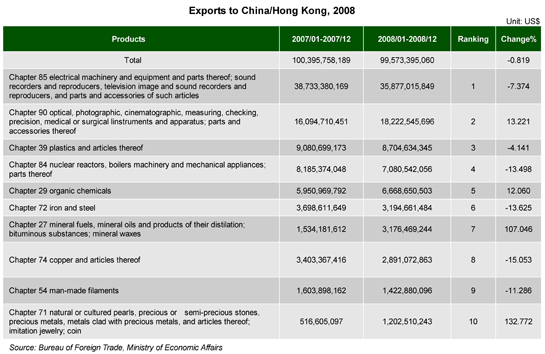

The New Zheng He Plan consists of practical measures, including organizing trade promotion delegations, led by ranking economic officials, to visit target markets; offering free plane tickets and other incentives to major foreign buyers to visit Taiwan; increasing subsidies for industry associations to organize trade-fair exhibition groups; and focusing on Taiwan's three key industries in the global market: auto parts, textile, and machine tool and machinery parts.
In addition, the plan enables the government to provide preferential loans to local exporters and foreign importers; organize procurement fairs in Taiwan; and help local firms bid for official tenders overseas.
Justifiable Confidence
Taiwan officials have justifiable reason to be confident of the export potential in emerging markets despite the global recession: In 2008, Taiwan's exports to Latin America, for instance, jumped 30% to US$7.2 billion, and rose 7.2% to US$38.9 billion to ASEAN.
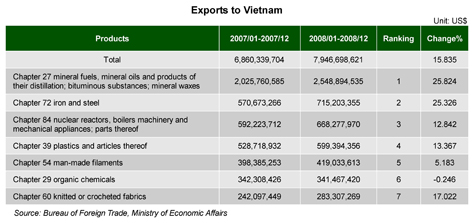
The Taiwan authorities are also determined to revive strong export growth for the mainland Chinese market, taking advantage of the improving Cross-Taiwan Strait relationship after President Ma Ying-jeou took office last May, and the sizable business opportunities created by China's 4 trillion-yuan local stimulus program, whose benefit is already being felt. The export-building effort will be facilitated by allowing direct Cross-Strait transportation links, expected to help Taiwanese traders save some US$1 billion in shipping costs annually.
Retain Edge With ECFA
Meanwhile and to consolidate Taiwan's trade status in the Chinese market, Taiwan wishes to sign an Economic Cooperation Framework Agreement (ECFA) with China, safeguarding its edge against ASEAN exporters, who will be armed with the "ASEAN plus one (China)" arrangement to be effective in 2010. The pact will allow ASEAN exporters duty-free status in the Chinese market, giving them an edge over Taiwanese rivals, especially in the fields of petrochemical, electronic parts and components, textile, and machine tools. Such impact will be even greater after Japan and South Korea join the pact in the so-called "ASEAN plus three."
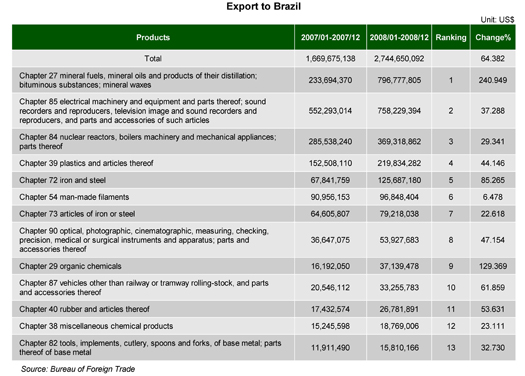
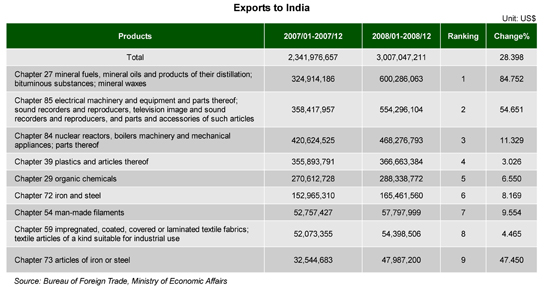
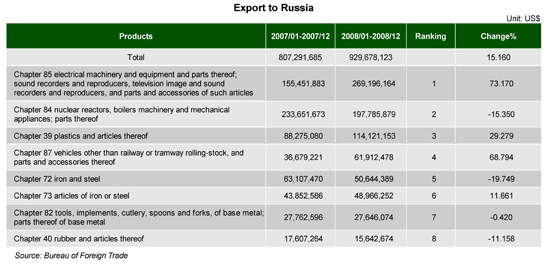
The ECFA to be signed between Taiwan and China addresses wide-ranging issues, including tariff, non-tariff barriers, investment protection, avoidance of double taxation, protection of intellectual properties, and trade dispute resolution, with a framework similar to that between China and ASEAN. The pact would allow related parties to agree on urgent issues while being on common ground, as well as prioritize dealing with such issues to achieve immediate result, leaving others for further, incremental negotiations.
The New Zheng He Plan will see the Bureau of Foreign Trade (BOFT), under the Ministry of Economic Affairs (MOEA) and executor of the plan, organize over 70 trade promotion delegations to visit emerging markets in 2009.
Sao Paulo Visit Fruitful
A trade delegation consisting of 70 firms, for instance, visited Brazil this March. The meeting in Sao Paulo attracted 350 Brazilian firms, who placed US$6 million in spot orders, with follow-up orders estimated at US$23 million. Brazil is a priority market being targeted by the BOFT, as Taiwan's exports to that market soared 64.4%, the highest among all markets, to US$2.744 billion in 2008, with major export items being electronic parts/components, auto parts, hi-tech products, and machine tools.
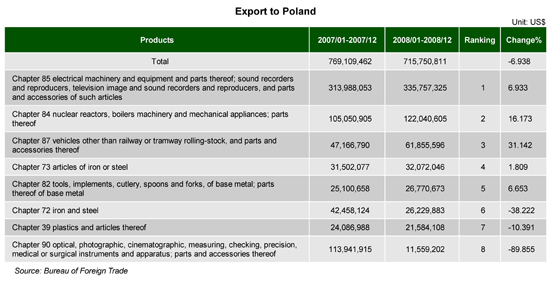
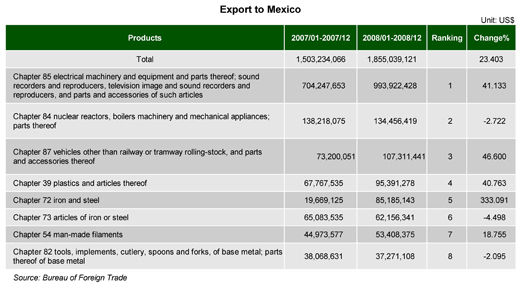
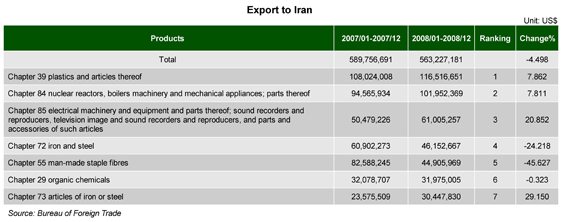
Another major target market is Mexico, which imported US$1.86 billion of Taiwan-made products in 2008, up 23.4%, with major items including electrical machinery and home appliances, machinery, auto parts, plastic products, and steel.
Another priority market, India imported US$30 billion of items from Taiwan in 2008, up 28.4%, for the second highest growth among Taiwan's overseas markets, with major items including electrical machinery and home appliances, machinery, plastic products, and steel. Taiwan External Trade Development Council's (TAITRA) third "TAITRONICS India," promoting Taiwan-made electronics products and machinery, to be staged in Chennai during September 11-13 will help to boost such trade. Other delegations will also be formed to tap India's markets for machinery, machine tool, agricultural products, construction, and environmental protection.
Exports to Russia Promising
Also eyeing Russia, the BOFT will sponsor product demonstrations and press conferences there to enhance brand image and profile of Taiwan-made products. Taiwan's exports to the country rose 15% to US$929.7 million in 2008, with major items being electrical machinery and home appliance, machinery, plastic products, auto parts, steel, and hardware.
Trade delegations will also visit ASEAN markets to tap the machinery, medical devices, machine tool, construction, and environmental protection sectors. One major market in ASEAN is Vietnam, which imported US$7.9 billion of Taiwan-made products in 2008, up 15.8%, with main items including steel, machinery, plastic products, manmade fiber, and organic chemicals. Another major market, Indonesia's imports supplied by Taiwan jumped 22.5% to US$3.6 billion in 2008.
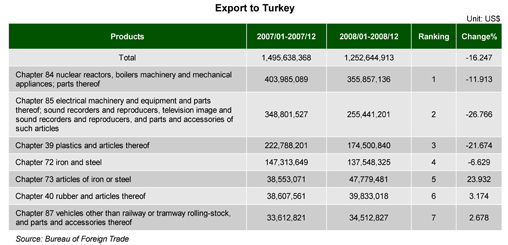
Several trade delegations will visit the Middle East, including one focusing on general trade, one on the photovoltaic industry, and another on food production. One major target is the United Arab Emirates, which imported US$1.5 billion of products from Taiwan last year, up 4.4%, with major items including electrical machinery and home appliance, machinery, plastic products, auto parts, and steel.

